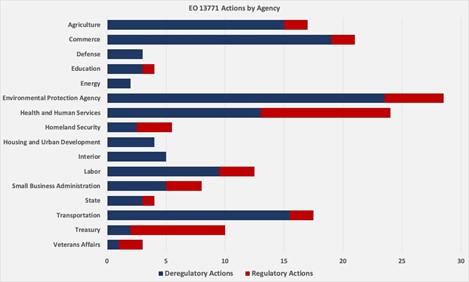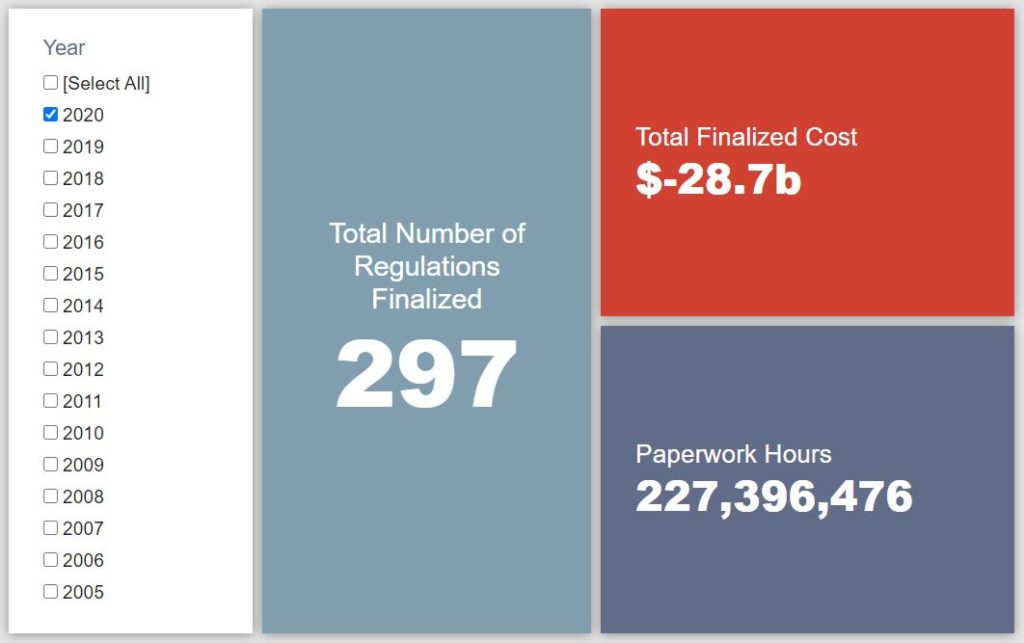Week in Regulation
October 5, 2020
The Second-Most Expensive Rule on Record
Last week saw the end of September and thus the end of the Trump Administration’s fiscal year (FY) 2020 regulatory budget window. That would normally be the most significant regulatory development to focus on. A single rule, however, may overshadow that story. A “Defense Federal Acquisition Regulation” (DFAR) seeking to address federal contractors’ cybersecurity measures hit the Federal Register and brought with it the second-highest price tag that the American Action Forum (AAF) has tracked thus far. Across all rulemakings, agencies published $94.8 billion in total net costs and added 687,575 hours of annual paperwork.
REGULATORY TOPLINES
- Proposed Rules: 46
- Final Rules: 73
- 2020 Total Pages: 62,461
- 2020 Final Rule Costs: -$28.7 billion
- 2020 Proposed Rule Costs: $16.3 billion
TRACKING THE REGULATORY BUDGET
As noted above, the most significant rule of the week was the Department of Defense (DOD) measure regarding cybersecurity standards. The rule seeks to “to implement a DoD Assessment Methodology and Cybersecurity Maturity Model Certification framework in order to assess contractor implementation of cybersecurity requirements and enhance the protection of unclassified information within the DoD supply chain.” DOD estimates that the rule’s requirements would yield nearly $93 billion in total costs for affected contractors. Part of the reason for this is that – for the highest level (“Level 5”) of certification – per entity costs could be $1.23 million in upfront costs and nearly $385,000 on a recurring basis.
Per AAF’s regrodeo.com tracking of rules going back to 2005, this places it second to only the Obama-era fuel efficiency standards rule in terms of total costs. Despite its extraordinary estimated economic impact and its publication on the penultimate day of FY 2020, DOD states that it does not apply to the FY 2020 regulatory budget under a national security exemption. If it did apply to the regulatory budget, it would have significantly diminished the administration’s top-line savings figure.
The Trump Administration expected to reach $51.6 billion in cumulative net savings in FY 2020, which as noted, ended last week. As further explored in AAF’s final regulatory budget projection, agencies have officially published 133 deregulatory actions and 46 regulatory actions, totaling $171.7 billion in quantified total net cost savings. A brief look at how agencies fared in terms of how their deregulatory-to-regulatory action counts follows below.
THIS WEEK’S REGULATORY PICTURE
One of the unfortunate things about the timing of the end of the federal fiscal year is that it usually coincides with Katmai National Park’s “Fat Bear Week.” As much as we would like to feature glorious specimens like 2019’s winner in this space, alas the regulatory budget takes precedent.
With FY 2020 officially closed, we have a clearer picture of how the regulatory budget will shake out. While the piece linked above has a detailed analysis of the economic impacts of rules covered under the budget, this space focuses on the number of actions issued by agencies.

The chart above shows the number of deregulatory and regulatory actions issued by the major departments and agencies.
The Environmental Protection Agency (EPA) led all agencies in total actions (28.5 [half actions occur when rules are jointly issued with another agency]) and deregulatory actions (23.5). The Department of Commerce issued the second-most deregulatory actions (19) followed by the Department of Transportation (15.5).
The Department of Health and Human Services issued the most regulatory actions with 11. The Department of the Treasury issued the second most (8) followed by EPA (5).
While raw counts of actions are not useful in indicating the economic impacts of agency rules, they are helpful to show which agencies are continuing to search for opportunities to trim regulatory requirements.
TOTAL BURDENS
Since January 1, the federal government has published $12.4 billion in total net cost savings (with $28.7 billion from finalized rules) and 279.2 million hours of net annual paperwork burden increases (with 227.4 million hours due to final rules). Click here for the latest Reg Rodeo findings.












